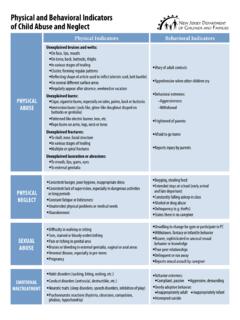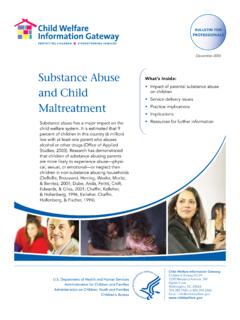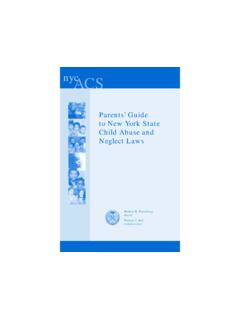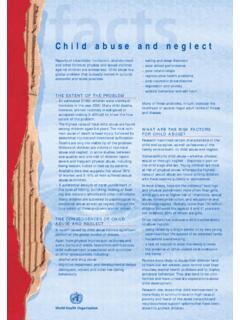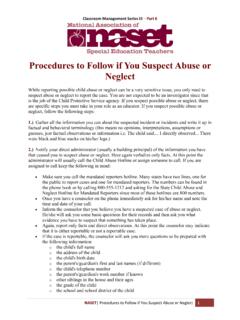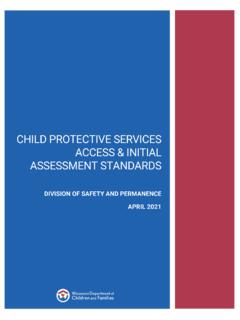Transcription of Connecting the Dots: An Overview of the Links Among ...
1 Preventionandequityat the center of community well-beingConnecting the Dots: An Overview of the Links Among Multiple Forms of ViolenceConnecting the Dots: An Overview of the Links Among Multiple Forms of Violence is a publication of the Centers for Disease Control and Prevention and Prevention for Disease Control and Prevention1 Thomas R. Frieden, MD, MPH, DirectorNational Center for Injury Prevention and Control Daniel M. Sosin, MD, MPH, FACP, Acting DirectorDivision of Violence Prevention Howard R. Spivak, MD, DirectorPrevention Institute2 Larry Cohen, MSW, Executive DirectorAuthorsNatalie Wilkins, PhD1 Benita Tsao, MPH, CHES2 Marci Hertz, MS1 Rachel Davis, MSW2 Joanne Klevens, MD, PhD, MPH1 July 2014 Suggested citation:Wilkins, N., Tsao, B., Hertz, M., Davis, R., Klevens, J. (2014). Connecting the Dots: An Overview of the Links Among Multiple Forms of Violence. Atlanta, GA: National Center for Injury Prevention and Control, Centers for Disease Control and Prevention Oakland, CA: Prevention the Dots 1 Gang violence is connected to bullying is connected to school violence is connected to intimate partner violence is connected to child abuse is connected to elder abuse.
2 It s all connected. -Deborah Prothrow-Stith, MD, Adjunct Professor, Harvard School of Public HealthViolence takes many forms, including intimate partner violence, sexual violence, child maltreatment , bullying, suicidal behavior, and elder abuse and neglect. These forms of violence are interconnected and often share the same root causes. They can also all take place under one roof, or in a given community or neighborhood and can happen at the same time or at different stages of ,2 Understanding the overlapping causes of violence and the things that can protect people and communities is important, and can help us better address violence in all its purpose of this brief is to share research on the connections between different forms of violence and describe how these connections affect communities. It is our hope that this information, combined with your own practical experience, will help practitioners like you to think strategically and creatively about how you can:1.
3 Prevent all types of violence from occurring in the first Coordinate and integrate responses to violence in a way that recognizes these connections and considers the individual in the context of their home environment, neighborhood, and larger community. There are experiences, particularly early in childhood, that make it extremely predictable that individuals are at substantially higher risk for involvement with violence, be it interpersonal, youth violence, intimate partner violence, dating violence, or child abuse. -Howard Spivak, MD, Director, Division of Violence Prevention, Centers for Disease Control and PreventionVulnerability and Resilience: Risk Factors and Protective Factors Violent behavior is complex. Many things increase or decrease the likelihood of violence. The communities people live in can protect them from violence or can increase their risk of violence. Things that make it more likely that people will experience violence are called risk factors.
4 Examples of risk factors are: rigid social beliefs about what is masculine and feminine, lack of job opportunities, and family conflict. Things that make it less likely that people will experience violence or that increase their resilience when they are faced with risk factors are called protective factors. Examples of protective factors are: connection to a caring adult or access to mental health services. Risk and protective factors can affect an entire community, and can occur in interactions with family and friends and within organizations and systems like schools, faith institutions, and workplaces. Individual experiences or traits can also be risk and protective factors, such as witnessing violence or having skills to solve problems non-violently. The table on pages 8 and 9 shows that some of the things that make it less likely for one type of violence to happen may also protect us from other types of violence.
5 2 Connecting the DotsThe Impact of Violence on Development People s brains develop in response to their When children grow up in safe,4,5,6 stable,7 and nurturing8 relationships and environments, they learn empathy, impulse control, anger management and problem-solving all skills that protect against When children grow up in environments where they don t feel safe, their brain cells form different connections with each other to better recognize and respond to ,11 Children in these environments may misinterpret neutral facial expressions as anger, for example,12 and more situations may trigger a fight-or-flight response. Children living in a persistently threatening environment are more likely to respond violently (fight) or run away (flight) than children who grow up in safe, stable, and nurturing environments. Fight-or-flight responses are survival skills that people are born with and often override other skills that enable non-violent conflict resolution, such as impulse control, empathy, anger management, and problem-solving ,14,11,15 Childhood abuse, neglect, and exposure to other traumatic stressors, termed adverse childhood experiences (ACEs), are common.
6 In the Adverse Childhood Experiences Study, over 17,000 adults from a Health Maintenance Organization (HMO) were asked about their experiences in childhood and subsequent behavioral and health outcomes. Almost two-thirds of participants reported at least one ACE, and more than one in five reported three or more The short- and long-term outcomes of these childhood exposures include multiple health and social problems. ACEs contribute to stress during childhood and put individuals at higher risk for health problems such as alcoholism and alcohol abuse, depression, illicit drug use, intimate partner violence, and suicide ,3 The impact of ACEs is also cumulative, meaning the more ACEs a child is exposed to, the higher likelihood they will experience some of these health and social problems later in life. The life expectancy of people with six or more ACEs is 20 years shorter than those without any are opportunities at every stage of life to remedy the negative effects of trauma and help people heal.
7 Whether designed for children, youth, or adults, actions and activities that promote the protective factors listed in the table on pages 8 and 9 may prevent trauma for those exposed to violence and also reduce the likelihood of violence in the first the Dots 3 Community Context and the Co-Occurrence of Multiple Forms of ViolenceCommunity risk and protective factors are critical because they make it more or less likely that entire communities will suffer from violence. The level of safety someone feels varies so much from community to community and even from block to block because safety is not evenly distributed. Often, a community experiences an overwhelming number of risk factors without an equal balance of protective factors. This means that families and children living in some communities where there are many risk factors ( , high poverty, unemployment, and crime) are more likely than families and children living in other communities to experience multiple forms of violence.
8 18,19,20 For example: Neighborhoods where there is low cohesion, or where residents don t support and trust each other, are more likely to have residents that also experience child maltreatment ,21,22 intimate partner violence,19 and youth People who are socially isolated and who don t have social support from family, friends, or neighbors are more likely to perpetrate child maltreatment ,23 intimate partner violence,24 suicide,25,26 and elder Lack of economic opportunities and unemployment are associated with perpetration of child maltreatment ,23 intimate partner violence,28,19 self-directed violence,29,30 sexual violence,31 and youth Norms in society or in communities that support aggression or coercion are associated with physical assaults of children,33,34 intimate partner violence,19 sexual violence,35 youth violence,36 and elder Witnessing community violence puts people at higher risk of being bullied37 and perpetrating sexual , this also means that community protective factors may make it less likely that an entire community will experience violence.
9 Things that increase peoples and communities resilience to violence include: Coordination of resources and services Among community ,40,41,27 Access to mental health and substance abuse ,41 Support and connectedness, including connectedness to one s community,42,19,38,43,41,27,44 family,42,45,46,47,41 pro-social peers,45,48 and ,49,50,46,37,41 4 Connecting the DotsOther Shared Risk and Protective Factors In addition to the things in communities that put people at risk for and/or protect them from violence, there are other things in people s relationships and past experiences that increase their risk or protect against violence. These other risk and protective factors are important because they often occur at the same time as larger community risk and protective factors and can further increase people s risk or resilience related to violence. For example, parents may have a harder time preventing their children from using substances (drugs, alcohol) or weapons when there are high levels of community violence in their neighborhood, putting youth already exposed to violence in their community at even higher risk for experiencing other forms of There are a number of these risk factors that occur as a result of people s experiences, skills, behaviors, and relationships that put them at higher risk of acting violently.
10 For example: Conflict within the family is linked to almost all forms of violence perpetration including child maltreatment (children in homes with high conflict are at higher risk for being victims),42 teen dating violence,52 intimate partner violence,53 sexual violence,31 youth violence,46 and Youth who associate with delinquent peers or friends are at higher risk of harming others through bullying,37 youth violence,46 teen dating violence,45 and later in life sexual violence,31 and intimate partner Experiencing one form of violence places individuals at a higher risk of experiencing other forms of violence (See Violence Can Lead to More Violence on page 4). Lacking skills to cope with problems non-violently42,27,55,37,46,56,57,53,52 and problems with substance abuse42,27,41,58,46,31,53,52 also place individuals at higher risk for acting violently. Relationships and past experiences and skills can also help protect people from violence even if they are exposed to violence in their For example, we know that people who live in communities that are violent can be protected from the effects of this violence (are less likely to perpetrate violence or engage in other destructive behaviors like substance use) if they have non-violent, supportive relationships with family, friends, and other groups, like schools or ,51,60 For example.










